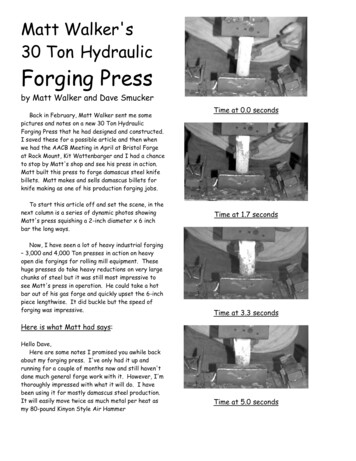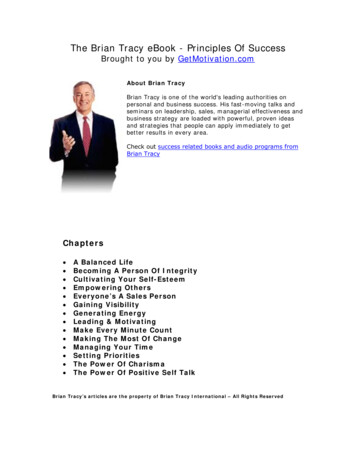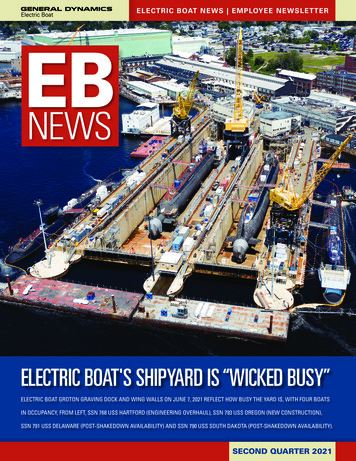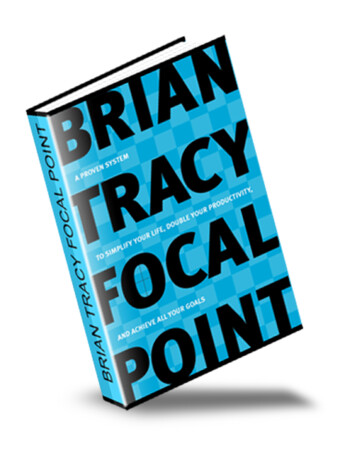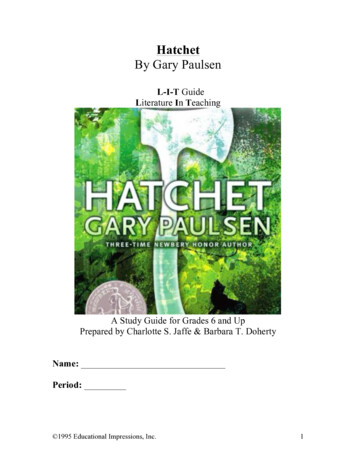
Transcription
Matt & Brian’sStolen slide guideGeneral class licensewww.hamclass.org
Amateur RadioGeneral Class LicenseClass SyllabusBased on July 1, 2015 to July 1, 2019 Question PoolJack Tiley AD7FO, Spokane Valley, WARevision: 1.02 – 19 June 2015 Jack Tiley - January 2015Proof read by Rick Nungester WA6NDRPlease email the Author at ad7fo@arrl.net before usingthis syllabus to insure you have the latest revision.1
General License Class SyllabusWritten by Jack Tiley AD7FOAll questions are shown exactly as they will appear in the test with only the correct answer shown (in greenbold text), which in the author’s view makes it easier when you see the other choices in your exam toidentify the correct answer. Question numbers have been included so you can go to the ARRL General ClassLicense Manual, or the question pool itself at (http://ncvec.org/page.php?id 364), to see the additionalchoices in the exam for each question.This material is based on the published 2015 General Class License question pool, effective July 1, 2015,with additional information added by the author (in italicized blue text).You do not need a copy of the current ARRL General Class License Manual. All of the questions that maybe in the exam are contained in this syllabus. It is suggested you obtain a recent copy of the ARRLHandbook which will serve as a useful as a reference to help understand the technical areas covered in thissyllabus and for Ham Radio in general. You do not need the latest edition of the ARRL Handbook, anyedition within the past 5-8 years is sufficient as the technical content does not change.Many of the illustrations used in this syllabus were copied from the ARRL Handbook CDROM, scanned from the license manual with permission from the copyright owner, ARRL,as well as other public sites on the web. This document has been written to assist studentsand instructors and may be distributed freely as long as no charge for the material is made(except for reproduction costs associated with delivering paper copies or electronic copieson CD-ROM’s) and this note of copyright permission is not removed.The electronic file of this syllabus may be too large to be e-mailed so an alternate form of distribution such ascolor printed copies, CD-ROM or web posting will be required (it is recommended if this is posted to a website that you link that site to the Inland Empire VHF club web site www.vhfclub.org which will always havethe latest revision).While every effort was made to insure the accuracy of the material herein, this material was prepared by anordinary human being and it is likely that a few typographical, spelling or other errors remain. The authorcan be contacted at ad7fo@arrl.net. Corrections are always welcome and appreciated.Additional information and resources to help you study for the General Class License can be found on theARRL web site (www.arrl.org). This site has articles and resources for reference materials on all aspects ofthe exam questions and Amateur Radio in general.2
Authors class Requirements when he is teaching a General license class.1. It is required that students each have a color printed copy of this syllabus to study from and that they bringto class. The instructor will be teaching from the syllabus during the class. All the possible questions thatcould be in the exam are covered in this syllabus.This syllabus in addition to the Extra and Technician syllabus’s may be down loaded from the Inland EmpireVHF Club web site www.vhfclub.org under the Training link on the home page.2. A printed and bound copy of this syllabus can be purchased from The UPS Store located at 2910 East 57thAvenue #5, Spokane, WA 99223 Phone (509) 448-6368 (ask for Mike-KD7GHZ or Richard- KE7DQC) foraround 12. These can be picked up at the store or can be ordered and shipped to a student.3. Students will need a basic scientific calculator that they are familiar with operating that is capable ofnormal math functions, square roots, trigonometry and Base 10 Log functions (all basic scientific calculatorshave these functions). Scientific calculators are available from office supply stores for around 10 to 15 ifyou do not already have one. The Texas Instrument 30 Series calculators meet these requirements. It isrecommended you do not purchase a programmable calculator as it may not be allowed in the test session.Cell phone calculators are not allowed in test sessions.4. Students need a desire to learn and to ask questions if they do not understand something that is beingtaught.5. To obtain a General license upgrade students must have passed the Technician license (Element 2) examand take and pass the General Class written exam (element 3)· There are 35 questions on the General exam,o All questions are multiple choices (4 choices). You must obtain a passing score of 74%(26 correct answers).o Questions come from a published pool of questions (all possible questions are coveredin this syllabus).o The number of possible questions for each topic area is fixed and shown for eachquestion group in the syllabus.6. There are a number of on-line practice sites with practice exams you can take with real exam questions forpractice. Listed below are three sites where you can find practice mradiolicenseexam.comLicense search websites (find your license or someone else’s arrl.org/fcc/searchhttp://www.qrz.com3
About The AuthorEducation:Electrical Engineering, Penn State UniversityWork Experience:Hewlett Packard: Thirty four years filling various positions (retired in 2004)· RF Products Division in Spokane WA – 1981 to 2004 - Regional Sales Support, ApplicationEngineering, World Wide Sales Management, Systems Development and ProductManagement· Valley Forge PA - from 1969 until 1981 - Engineering Technical Support, TechnicalCustomer Training and Field Sales EngineerAmerican Electronics Laboratories: Nine years working in and managing a Metrology (CalibrationStandards) Laboratory responsible for maintaining test instruments and their calibration traceability to theNational Bureau of Standards (NBS) now the National Institute of Standards and Technology (NIST) inColmar Pennsylvania.Jerrold Electronics: 2 years as a Technician at Jerrold Electronics R&D Laboratory in Hatboro PA.Hobbies:··Amateur Radio, Test Equipment, Electronics in general.Teaching amateur radio classesAmateur Radio Activities: Teaching and mentoring. Teaching Technician (1 day class), General (2 day class) and Extra (3 dayclass) License Classes using training materials I have developed.Teaching ARRL EMCOMM class with a power point presentation I have written (2-1/2 day class)Wrote and presented twenty plus one hour technical talks for local ham radio clubs (Available fromthe Author).I provide a radio and general purpose test table every year at the Spokane Hamfest for folks to testtheir radios and other electronic hamfest treasures.Attending as many hamfests as I canARRL Appointments:§§§§§ARRL VE (Volunteer Examiner)ARRL Technical Specialist for Spokane areaARRL Technical Coordinator for EWAARRL Registered InstructorARRL Certified EMCOMM instructorOther: Officer in the Inland Empire VHF ClubMember of the Spokane County ARES/RACES (past AEC)4
2015-2019 General Class – FCC Element- 3Effective July 1, 2015 thru July 1 2019SUBELEMENT G1 COMMISSION'S RULES[5 Exam Questions-5 Groups]G1A - General Class control operator frequency privileges; primary and secondary allocationsG1B - Antenna structure limitations; good engineering and good amateur practice; beacon operation;prohibited transmissions; retransmitting radio signalsG1C - Transmitter power regulations; data emission standardsG1D - Volunteer Examiners and Volunteer Examiner Coordinators; temporary identificationG1E – Control categories; repeater regulations; harmful interference; third party rules; ITU regions;automatically controlled digital stationSUBELEMENT G2 OPERATING PROCEDURES[5 Exam Questions-5 Groups]G2A - Phone operating procedures; USB/LSB conventions; procedural signals; breaking into a contact; VOXoperationG2B - Operating courtesy; band plans; emergencies, including drills and emergency communicationsG2C - CW operating procedures and procedural signals; Q signals and common abbreviations; full break inG2D - Amateur Auxiliary; minimizing interference; HF operationsG2E - Digital operating; procedures, procedural signals and common abbreviationsSUBELEMENT G3 RADIO WAVE PROPAGATION[3 Exam Questions-3 Groups]G3A - Sunspots and solar radiation; ionospheric disturbances; propagation forecasting and indicesG3B - Maximum Usable Frequency; Lowest Usable Frequency; propagationG3C - Ionospheric layers; critical angle and frequency; HF scatter; Near-Vertical Incidence SkywaveSUBELEMENT G4 AMATEUR RADIO PRACTICES[5 Exam Questions-5 groups]G4A – Station Operation and set upG4B - Test and monitoring equipment; two-tone testG4C - Interference with consumer electronics; grounding; DSPG4D - Speech processors; S meters; sideband operation near band edgesG4E - HF mobile radio installations; emergency and battery powered operation5
SUBELEMENT G5 ELECTRICAL PRINCIPLES[3 Exam Questions–3 Groups]G5A - Reactance; inductance; capacitance; impedance; impedance matchingG5B - The Decibel; current and voltage dividers; electrical power calculations; sine wave root-mean-square(RMS) values; PEP calculationsG5C – Resistors, capacitors, and inductors in series and parallel; transformersSUBELEMENT G6 CIRCUIT COMPONENTS[2 Exam Questions–2 Groups]G6A – Resistors; Capacitors; Inductors; Rectifiers; solid state diodes and transistors; vacuum tubes; batteriesG6B - Analog and digital integrated circuits (ICs); microprocessors; memory; I/O devices; microwave ICs(MMICs); display devicesSUBELEMENT G7 PRACTICAL CIRCUITS[3 Exam Questions–3 Groups]G7A Power supplies; and schematic symbolsG7C - Receivers and transmitters; filters, oscillatorsSUBELEMENT G8 SIGNALS AND EMISSIONS[3 Exam Questions–3 Groups]G8A - Carriers and modulation; AM; FM; single sideband; modulation envelope; digital modulation; overmodulationG8B - Frequency mixing; multiplication; bandwidths of various modes; deviationG8C – Digital emission modesSUBELEMENT G9 ANTENNAS AND FEEDLINES[4 Exam Questions–4 Groups]G9A - Antenna feed lines; characteristic impedance, and attenuation; SWR calculation, measurement andeffects; matching networksG9B - Basic antennasG9C - Directional antennasG9D - Specialized antennasSUBELEMENT G0 ELECTRICAL AND RF SAFETY[2 Exam Questions–2 Groups]G0A - RF safety principles, rules and guidelines; routine station evaluationG0B - Safety in the ham shack; electrical shock and treatment, safety grounding, fusing, interlocks, wiring,antenna and tower safety6
7
SUBELEMENT G1 - COMMISSION'S RULES[5 Exam Questions - 5 Groups]Note: The number in brackets after the question number is the FCC Part 97 rule thatapplies.G1A - General Class control operator frequency privileges; primary and secondaryallocationsnote: See the US Amateur Radio Bands chart on Page 7 for questions G1A01 thru G1A11.G1A01 [97.301(d)]On which of the following bands is a General Class license holder granted all amateur frequency privileges?160, 60, 30, 17, 12, and 10 metersAmateur Radio frequency bands are frequently referred to by their wavelength. Wavelength (meters) isequal to the speed of light (meters per second) divided by the frequency (Hz). Since the speed of light isapproximately 3,000,000meters per second the wavelength is equal to 300,000,000 Frequency (Hz).or 300 frequency (MHz)G1A02 [97.305]On which of the following bands is phone operation prohibited?30 metersOnly RTTY and data are allowed on 30 metersG1A03 [97.305]On which of the following bands is image transmission prohibited?30 metersSee answer above in G1A02G1A04 [97.303 (h)]Which of the following amateur bands is restricted to communication on only specific channels, rather thanfrequency ranges?60 meters8
G1A05 [97.301(d)]Which of the following frequencies is in the General Class portion of the 40-meter band?7.250 MHzThe test question has only two reasonable answers for the 40 meter band specified in the question both7.25 MHz and 7.50 MHz would be reasonable choices. If you calculate the band frequency using theformula frequency(MHz) 300/band then dividing the band (40 meters) into 300 (frequency 300 40) bythe band you would come up with an answer somewhere close to 7.5 MHz, but the question asks whichfrequency is in the general class portion of the band. If you look at the US Amateur Radio Bands on page7 you will see that the 40 meter amateur band stops at 7.3 MHz. so therefore the 7.25 MHz answer wouldbe correct.G1A06 [97.301(d)]Which of the following frequencies is within the General Class portion of the 75-meter phone band?3,900 kHzThe General class portion of the 80 meter band is from 3.525 MHz to 3.600 MHz but restricted RTTY anddata, no voice (phone) allowed. The 3.8 to 4.00 MHz is available for voice (phone). The 80 meter band issometimes referred to as the 75 and 80 meter band.G1A07 [97.301(d)]Which of the following frequencies is within the General Class portion of the 20-meter phone band?14,305 kHzThe General class portion of the 20 meter phone band is from 14,225 kHz to 14,350 kHz.G1A08 [97.301(d)]Which of the following frequencies is within the General Class portion of the 80-meter band?C. 3560 kHzThe General class portion of the 80 meter band is from 3,525 kHz to 3,600 kHz and3,700 kHz to 4,000 kHz9
G1A09 [97.301(d)]Which of the following frequencies is within the General Class portion of the 15-meter band?21,300 kHzThe General class portion of the 15 meter band is from 21,025 kHz to 21,200 kHz and 21,275 kHz to21,450 kHzG1A10 [97.301(d)]Which of the following frequencies is available to a control operator holding a General Class license?A. 28.020 MHzB. 28.350 MHzC. 28.550 MHzD. All of these choices are correctThe General class portion of the 10 meter band is from 28.000 MHz to 29.700 MHzG1A11 [97.301]When General Class licensees are not permitted to use the entire voice portion of a particular band, whichportion of the voice segment is generally available to them?The upper frequency endG1A12 [97.303]Which of the following applies when the FCC rules designate the Amateur Service as a secondary user on aband?Amateur stations are allowed to use the band only if they do not cause harmful interference toprimary usersThe 30 meter and 60 meter bands are examples of where we are secondary users.10
G1A13 [97.303(h)(2)(j)]What is the appropriate action if, when operating on either the 30- or 60- meter bands, a station in the primaryservice interferes with your contact?Move to a clear frequency or stop transmittingG1A14 [97.301(d)]In what ITU region is operation in the 7.175 to 7.300 MHz band permitted for a control operator holding anFCC issued General Class license?Region 2G1B - Antenna structure limitations; good engineering and good amateur practice;beacon operation; prohibited transmissions; retransmitting radio signalsG1B01 [97.15(a)]What is the maximum height above ground to which an antenna structure may be erected without requiringnotification to the FAA and registration with the FCC, provided it is not at or near a public use airport?200 feetG1B02 [97.203(b)]With which of the following conditions must beacon stations comply?There must be no more than one beacon signal transmitting in the same band from the samestation locationThe northern California DX Foundation (NCDXF) in cooperation with the International Amateur RadioUnion (IARU) has constructed and operates a worldwide network of High Frequency (HF) radio beaconsoperating at 100 watts on 14.100, 18.110, 21.150 and 28.200 MHz. These beacons help both AmateurRadio and commercial HF radio users to access the current condition of the atmosphere and to determinewhere the band is open. The entire system has been built and is operated by volunteers at no cost.11
In principle, one can simply listen on the beacon frequencies and copy the CW call signs of the variousbeacons (sent at 22 WPM). Because transmit times are precisely known it is easy to know which beaconyou are hearing whether you can copy the code or if the signal is weak.G1B03 [97.3(a)(9)]Which of the following is a purpose of a beacon station as identified in the FCC rules?Observation of propagation and receptionG1B04 [97.113(b)]Which of the following must be true before amateur stations may provide communications to broadcasters fordissemination to the public?The communications must directly relate to the immediate safety of human life or protection ofproperty and there must be no other means of communication reasonably available before or atthe time of the eventG1B05 [97.113(c)]When may music be transmitted by an amateur station?When it is an incidental part of a manned space craft retransmission.Not at any other time. Be sure any stereos, radios or TV’s cannot be heard in the background when youtransmit.G1B06 [97.113(a)(4) and 97.207(f)]When is an amateur station permitted to transmit secret codes?To control a space stationSecret codes are not allowed at any time or for any other purpose other than space station control.G1B07 [97.113(a)(4)]What are the restrictions on the use of abbreviations or procedural signals in the Amateur Service?They may be used if they do not obscure the meaning of a messageProcedurals are three letter abbreviations originally used to shorten transmissions on CW. Examples areincluded in the Reference materials section at the end on pages 106 to 109.G1B08 [97.101(a)]When choosing a transmitting frequency, what should you do to comply with good amateur practice?A. Insure that the frequency and mode selected are within your license class privilegesB. Follow generally accepted band plans agreed to by the Amateur Radio community.C. Monitor the frequency before transmittingD. All of these choices are correctG1B09 [97.113(a)(3)]When may an amateur station transmit communications in which the licensee or control operator has apecuniary (monetary) interest?When other amateurs are being notified of the sale of apparatus normally used in an amateurstation and such activity is not done on a regular basisG1B10 [97.203(c)]What is the power limit for beacon stations?100 watts PEP outputPEP is the Peak Envelope Power of your transmission (see page 95 in the appendix).12
G1B11 [97.101(a)]How does the FCC require an amateur station to be operated in all respects not specifically covered by thePart 97 rules?In conformance with good engineering and good amateur practiceG1B12 [97.101(a)]Who or what determines "good engineering and good amateur practice" as applied to the operation of anamateur station in all respects not covered by the Part 97 rules?The FCC (Federal Communications Commission)G1C - Transmitter power regulations; data emission standardsG1C01 [97.313(c)(1)]What is the maximum transmitting power an amateur station may use on 10.140 MHz?200 watts PEP output200 watt PEP is the maximum allowed on the 30 meter band and 10.140 is in the 30 meter band.G1C02 [97.313(a),(b)]What is the maximum transmitting power an amateur station may use on the 12-meter band?1500 watts PEP outputG1C03 [97.303(h)(1)]What is the maximum bandwidth permitted by FCC rules for Amateur Radio stations transmitting on USBfrequencies in the 60-meter band?2.8 kHznote: See US Amateur Radio Band Plan on page 7.G1C04 [97.313(a)]Which of the following limitations apply to transmitter power on every amateur band?Only the minimum power necessary to carry out the desired communications should be usedG1C05 [97.313(c)(2)]Which of the following is a limitation on transmitter power on the 28 MHz band for a General Class controloperator?1500 watts PEP outputG1C06 [97.313]Which of the following is a limitation on transmitter power on the 1.8 MHz band?1500 watts PEP output13
G1C07 [97.305(c), 97.307(f)(3)]What is the maximum symbol rate permitted for RTTY or data emission transmission on the 20-meter band?300 baudThe speed of the data is expressed in bits per second or Baud Rate. Baud rate refers to the number ofsignal or symbol changes that occur per second. A symbol may contain one or more bits.G1C08 [97.307(f)(3)]What is the maximum symbol rate permitted for RTTY or data emission transmitted at frequencies below 28MHz?300 baudFor frequencies below 28 MHz. the maximum baud rate for RTTY is 300.For frequencies in the 10 meter band the maximum baud rate for RTTY is 1200.For frequencies in the 2 meter band the maximum baud rate for RTTY is 19.6K.For frequencies below 1.25 meter band the maximum baud rate for RTTY is 56K.G1C09 [97.305(c) and 97.307(f)(5)]What is the maximum symbol rate permitted for RTTY or data emission transmitted on the 1.25-meter and70-centimeter bands?56 kilobaudG1C10 [97.305(c) and 97.307(f)(4)]What is the maximum symbol rate permitted for RTTY or data emission transmissions on the 10-meter band?1200 baudG1C11 (B) [97.305(c) and 97.307(f)(5)]What is the maximum symbol rate permitted for RTTY or data emission transmissions on the 2-meter band?19.6 kilobaudG1D - Volunteer Examiners and Volunteer Examiner Coordinators; temporaryidentificationG1D01 [97.501, 97.505(a)]Who may receive credit for the elements represented by an expired amateur radio license?Any person who can demonstrate that they once held a FCC issued General, Advanced, orAmateur Extra class license that was not revoked by the FCC.This means that if you have an expired General, Advanced or Extra license that expired more than twoyears ago you can have your license re-instated to its previous level by producing a copy of your old licenseor a copy of your name and call sign in an old call book and re-taking and passing the level 2 (Technician)license exam, assuming your license was not revoked by the FCC.G1D02 [97.509(b)(3)(i)]What license examinations may you administer when you are an accredited VE holding a General Classoperator license?Technician onlyG1D03 [97.9(b)]On which of the following band segments may you operate if you are a Technician Class operator and have aCSCE (Certificate of Successful Completion of Exam) for General Class privileges?On any General or Technician Class band segment14
G1D04 [97.509(3)(i)(c)]Which of the following is a requirement for administering a Technician Class license examination?At least three General Class or higher VEs must observe the examinationG1D05 [97.509(b)(3)(i)]Which of the following must a person have before they can be an administering VE for a Technician Classlicense examination?An FCC General Class or higher license and VEC accreditationG1D06 [97.119(f)(2)]When must you add the special identifier "AG" after your call sign if you are a Technician Class licensee andhave a CSCE (Certificate of Successful Completion of Exam) for General Class operator privileges, but theFCC has not yet posted your upgrade on its website?Whenever you operate using General Class frequency privilegesG1D07 [97.509(b)(1)]Volunteer Examiners are accredited by what organization?A Volunteer Examiner CoordinatorThere are two VEC’s: the ARRL VEC and the W5YI VECG1D08 [97.509(b)(3)]Which of the following criteria must be met for a non-U.S. citizen to be an accredited Volunteer Examiner?The person must hold an FCC granted Amateur Radio license of General Class or aboveG1D09 [97.9(b)]How long is a Certificate of Successful Completion of Examination (CSCE) valid for exam element credit?365 daysG1D10 [97.509(b)(2)]What is the minimum age that one must be to qualify as an accredited Volunteer Examiner?18 yearsG1D11 (D)If a person has an expired FCC issued amateur radio license of General Class or higher, what is requiredbefore they can receive a new license?The applicant must pass the current element 2 (Technician) examThey must also show proof of the previous license level that they held (a Copy of expired license or an oldcall book with their name and license listed).G1E – Control categories; repeater regulations; harmful interference; third party rules;ITU regions; automatically controlled digital stationG1E01 [97.115(b)(2)]Which of the following would disqualify a third party from participating in stating a message over an amateurstation?The third party’s amateur license has been revoked and not reinstatedHam radio is frequently used to send messages on behalf of unlicensed persons or organizations. One ofthe oldest activities is the sending of messages, relaying them from station to station until delivered by aAmateur Radio operator near the addressee. This is third party communication. The word Relay in theAmateur Radio Relay League (ARRL) refers to this amateur radio activity.15
G1E02 [97.205(b)]When may a 10-meter repeater retransmit the 2-meter signal from a station having a Technician Class controloperator?Only if the 10-meter repeater control operator holds at least a General Class licenseAn amateur radio repeater is a remote station that receives an amateur radio signal and retransmits it ona different frequency and usually at a higher power level, so that the signal can cover longer distancesbeyond line of sight. Repeaters are usually located on hilltops or on tall buildings. Amateur radiorepeaters are similar in concept to those used by public safety entities (police, fire department, businesses,government, military, and more). Amateur radio repeaters may use commercially packaged repeatersystems that have been adjusted to operate within amateur radio frequency bands, but more often amateurrepeaters are assembled from receivers, transmitters, controllers, power supplies, antennas, duplexers andother components, from various sources.G1E03 [97.221]What is required to conduct communications with a digital station operating under automatic control outsidethe automatic control band segments?The station initiating the contact must be under local or remote controlAutomatic control refers stations interfacing with the internetG1E04 [97.13(b), 97.303, 97.311(b)]Which of the following conditions require a licensed Amateur Radio operator to take specific steps to avoidharmful interference to other users or facilities?A. When operating within one mile of an FCC Monitoring StationB. When using a band where the Amateur Service is secondaryC. When a station is transmitting spread spectrum emissionsD. All of these choices are correctProtected FCC Monitoring Stations are located at the following geographical coordinates :Allegan, Michigan, 42 36'20.1" N. Latitude, 85 57'20.1" W. LongitudeBelfast, Maine, 44 26'42.3" N. Latitude, 69 04'56.1" W. LongitudeCanandaigua, New York, 42 54'48.2" N. Latitude, 77 15'57.9" W. LongitudeDouglas, Arizona, 31 30'02.3" N. Latitude, 109 39'14.3" W. LongitudeFerndale, Washington, 48 57'20.4" N. Latitude, 122 33'17.6" W. LongitudeGrand Island, Nebraska, 40 55'21.0" N. Latitude, 98 25'43.2" W. LongitudeKenai, Alaska, 60 43'26.0" N. Latitude, 151 20'15.0" W. LongitudeKingsville, Texas, 27 26'30.1" N. Latitude, 97 53'01.0" W. LongitudeLaurel, Maryland, 39 09'54.4" N. Latitude, 76 49'15.9" W. LongitudeLivermore, California, 37 43'29.7" N. Latitude, 121 45'15.8" W. LongitudePowder Springs, Georgia, 33 51'44.4" N. Latitude, 84 43'25.8" W. LongitudeSanta Isabel, Puerto Rico, 18 00'18.9" N. Latitude, 66 22'30.6" W. LongitudeVero Beach, Florida, 27 36'22.1" N. Latitude, 80 38'05.2" W. LongitudeWaipahu, Hawaii, 21 22'33.6" N. Latitude, 157 59'44.1" W. Longitude16
G1E05 [97.115(a)(2),97.117]What types of messages for a third party in another country may be transmitted by an amateur station?Only messages relating to Amateur Radio or remarks of a personal character, or messagesrelating to emergencies or disaster reliefG1E06 [97.205(c)]Which of the following applies in the event of interference between a coordinated repeater and anuncoordinated repeater?The licensee of the uncoordinated repeater has primary responsibility to resolve theinterferenceG1E07 [97.115(a)(2)]With which foreign countries is third party traffic prohibited, except for messages directly involvingemergencies or disaster relief communications?Every foreign country, unless there is a third party agreement in effect with that countryA list of countries with third party agreements is listed in the appendix on pages 104 and 105.G1E08 [97.115(a)(b)]Which of the following is a requirement for a non-licensed person to communicate with a foreign AmateurRadio station from a station with an FCC-granted license at which an FCC licensed control operator ispresent?The foreign amateur station must be in a country with which the United States has a third partyagreementG1E09 [97.119(b)(2)]What language must be used when identifying your station if you are using a language other than English inmaking a contact using phone emission?English onlyG1E10 [97.205(b)]What portion of the 10-meter band is available for repeater use?The portion above 29.6 MHzG1E11 [97.221]Which of the following is the FCC term for an unattended digital station that transfers messages to and fromthe Internet?Automatically controlled digital stationG1E12 [97.115]Under what circumstances are messages that are sent via digital modes exempt from Part 97 third party rulesthat apply to other modes of communication?Under no circumstancesG1E13 [97.221, 97.305]On what bands may automatically controlled stations transmitting RTTY or data emissions communicatewith other automatically controlled digital stations?Anywhere in the 1.25 meter or shorter wavelength bands, and in specified segments of the 80meter through 2-meter bandsSee the US Amateur Radio Band plan on page 7.17
SUBELEMENT G2 - OPERATING PROCEDURES[5 Exam Questions - 5 Groups]G2A - Phone operating procedures; USB/LSB conventions; proceduralsignals; break
Teaching Technician (1 day class), General (2 day class) and Extra (3 day class) License Classes using training materials I have developed. " Teaching ARRL EMCOMM class with a power point presentation I have written (2-1/2 day class) " Wrote and presented twenty plus one hour technical talks for local

